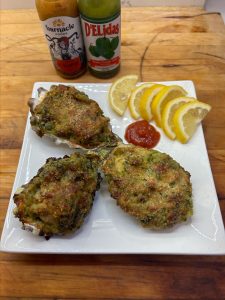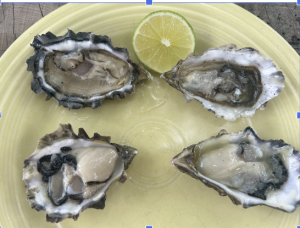Oysters Rockefeller, Oysters on the Half Shell, and Gul Jeon Rockefeller
By Mark Tagal
Oysters are the perfect blank canvas for a host of preparations and condiments. From something as simple as slurping a fresh raw oyster to eating a multi-layer dish that explodes with complex layers of flavor, the oyster is almost a perfect seafood. While exploring the concept of Merroir in seafood, it only makes sense to look at the versatile oyster for several delicious plates.
Oysters Rockefeller
 Created in New Orleans around 1899 and named after the wealthiest man in the world, Oyster Rockefeller might be the perfect entry-level for those new to oysters. During that time, it was said that the sauce’s richness reminded them of John D. Rockefeller, who had accumulated a large fortune. For the well-initiated oyster lover, this recipe is a welcome treat worth revisiting time and again. Oysters Rockefeller is a cooked oyster with a fair amount of flavor-forward ingredients. In terms of merroir, this bite of magic accommodates a wide range of species and varieties.
Created in New Orleans around 1899 and named after the wealthiest man in the world, Oyster Rockefeller might be the perfect entry-level for those new to oysters. During that time, it was said that the sauce’s richness reminded them of John D. Rockefeller, who had accumulated a large fortune. For the well-initiated oyster lover, this recipe is a welcome treat worth revisiting time and again. Oysters Rockefeller is a cooked oyster with a fair amount of flavor-forward ingredients. In terms of merroir, this bite of magic accommodates a wide range of species and varieties.
Ingredients
- Oysters – Any variety of oysters will work if you use fresh ones. Shuck the oysters and set aside for later.
- Onion – I recommend using onion along with garlic for the sauce that goes on top.
- Wine – Optional but adds to the depth of flavor in the oysters while cooking. Chardonnay, Pinot Grigio, or Sauvignon Blanc are all good choices.
- Cream – Heavy whipping cream creates a rich garlic sauce to cover the oysters.
- Spinach – Baby spinach is ideal, but fresh, stemmed spinach also works.
- Ham – Prosciutto ham is my favorite, though you can substitute it with cooked bacon, Pancetta, Canadian bacon, or ham.
- Cheese – A mix of Asiago and Parmesan cheeses works well.
- Breadcrumbs – Finish the dish with breadcrumbs before baking or broiling.
How to Make it
This dish takes three steps. The creamed spinach is then baked, and the rest is baked. To make the creamed spinach, sweat an onion until it is transparent. Add your heavy cream and spinach and stir until the leaves wilt. Set aside.
- Take your oyster and shuck. Be sure to save the shell. If you are not the best shucker, just drop it into a pot of boiling water for a minute or so. The oyster will pop open, and the meat will be easy to remove. Chop your ham, grate your cheese, and mix with breadcrumbs.
- Stuff the mixture back into the shell and broil for a few minutes to melt the cheese.
Oysters on the Half shell
 Perhaps the purest way to eat an oyster. Your only concern is making sure the oysters are good and cold. Cooking oysters will neutralize potentially harmful bacteria, but so will eating them before they have a chance to warm up. Proper handling and storage are crucial when consuming any raw seafood. Summer months are good months to avoid eating raw oysters, as summer months are when oysters are typically spawning. Spawning oysters are not as plump and meaty, and tend to have a runny texture. A good rule of thumb is if you are in a month that does not have a letter “R” in the spelling, then it is best to stick to other shellfish and wait for the fall to late spring to enjoy a raw oyster. You only need a solid shucking knife to eat a raw oyster. Popular condiments start with a few drops of lemon or lime but branch out. There are a host of condiments that elevate your half-shell experience. Classic Mignonette made of vinegar, minced shallots, and pepper. Hot sauces from around the world or Umami flavors from Asia. A squeeze here, a dash there, and you have the perfect bite of goodness on the half-shell.
Perhaps the purest way to eat an oyster. Your only concern is making sure the oysters are good and cold. Cooking oysters will neutralize potentially harmful bacteria, but so will eating them before they have a chance to warm up. Proper handling and storage are crucial when consuming any raw seafood. Summer months are good months to avoid eating raw oysters, as summer months are when oysters are typically spawning. Spawning oysters are not as plump and meaty, and tend to have a runny texture. A good rule of thumb is if you are in a month that does not have a letter “R” in the spelling, then it is best to stick to other shellfish and wait for the fall to late spring to enjoy a raw oyster. You only need a solid shucking knife to eat a raw oyster. Popular condiments start with a few drops of lemon or lime but branch out. There are a host of condiments that elevate your half-shell experience. Classic Mignonette made of vinegar, minced shallots, and pepper. Hot sauces from around the world or Umami flavors from Asia. A squeeze here, a dash there, and you have the perfect bite of goodness on the half-shell.
Ingredients
This is where all the wondrous varieties of oysters come into play. When choosing an oyster, you can explore Merrior’s true canvas.
How to Make it
- Shuck an oyster. Make sure to free it from the shell
- Add whatever you want to it
- Slurp it down.
Gul Jeon Rockefeller
 This takes a popular Korean oyster dish and modifies its presentation to fit onto your oyster platter. By serving it in the half shell with the Banchan (condiments) included, it has all the hallmarks of classic Rockefeller with the flavors of a seafood bar in Jeju.
This takes a popular Korean oyster dish and modifies its presentation to fit onto your oyster platter. By serving it in the half shell with the Banchan (condiments) included, it has all the hallmarks of classic Rockefeller with the flavors of a seafood bar in Jeju.
Ingredients
- Oysters – Fresh oysters you shuck yourself are the best. Using the oyster liquor only adds to the flavor, plus you get the shell to use for serving.
- Green Onion – Finely chopped green onion tops
- Kim Chee – The most common Korean Banchan has replaced the spinach in the Rockefeller recipe, but any of the ubiquitous side dishes can be substituted here.
- Flour – If you can find it, there is a ready-made mix for Korean oyster pancakes. The Korean name for this pancake is called Buchim Garu. If you can’t locate this specific flour then fine flour will work.
- Egg – You need this to make the pancake mixture.
- Flying Fish Roe – I like to replace the bacon with some of the eggs.
How to Make it
- Prepare your pancake mix. If you have the Korean pancake mix, follow the instructions on the box, but from scratch, mix 2-3 cups of flour with one egg.
- Shuck the oysters right into the pancake mix. Make sure you get all the oyster liquor, as it adds to the flavor. You may need to add a little water to the pancake mix to thin it out. You want the mix to be thin enough to easily coat the oysters but not so thin that it all runs off.
- Set the shells aside as you will need it when plating. Add finely chopped green onions.
- Fry the oysters in a little oil. They cook fast, so turn until they are a nice golden brown.
- Place oyster pancake into a clean oyster shell and top with your favorite kimchi.
- Top final presentation with green onions, and flying fish eggs.
These are only three of the ways to prepare oysters. Oysters are incredibly versatile and can be used in a multitude of seafood dishes. The many wonderful varieties of oysters can add to your exploration of this fascinating bivalve. Will one of these oyster recipes be your Perfect Bite? Shuck and enjoy!





